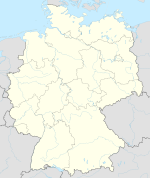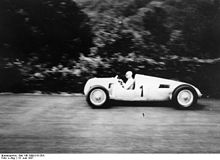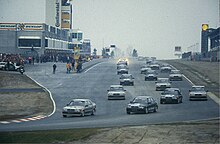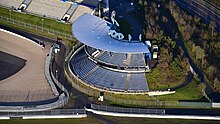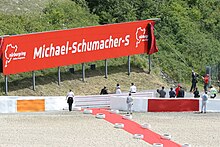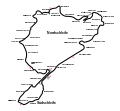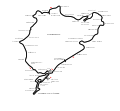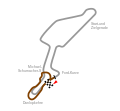Nürburgring

Address: |
|
|
|
|
||
| Route type: | permanent race track | |
|---|---|---|
| Owner: | Capricorn (since January 1, 2015) | |
| Architect: | Gustav Eichler, Ravensburg | |
| Building-costs: | 8.1 million Reichsmarks | |
| Start of building: | July 1, 1925 | |
| Opening: | June 18, 1927 | |
Formula 1 venue : |
1951–1976 (with Nordschleife) 1984–2020 (Grand Prix track) |
|
| Time zone: | UTC + 1 ( CET ) | |
| Nürburgring entire route | ||
| in this variant since 2002 | ||
| Route data | ||
| Important events: |
1000 km (until 1983); 24 hour race ; VLN ; | |
| Route length: | 26 km (16.16 mi ) | |
| Height difference: | 290 m (951.44 ft ) | |
| Curves: | 87 | |
| Curve superelevation: | today 2 | |
| Nürburgring Grand Prix track | ||
| in this variant since 2002 | ||
| Route data | ||
| Important events: |
DTM ; GP2 ; F3 Euro Series ; Superbike World Championship ; 1000 km (from 1984); ADAC GT Masters ; WEC ; formula 1 | |
| Route length: | 5.148 km (3.2 mi ) | |
| Height difference: | 55 m (180.45 ft ) | |
| Curves: | 16 | |
| Records | ||
| Track record: (automobile) |
1: 29.468 min. ( Michael Schumacher , Ferrari , 2004) |
|
| www.nuerburgring.de | ||
Coordinates: 50 ° 20 ′ 8.1 ″ N , 6 ° 56 ′ 51.3 ″ E
The Nürburgring is a race track named after the Nürburg in the area of the Verbandsgemeinde Adenau ( Ahrweiler district , Rhineland-Palatinate ) in the Eifel and was inaugurated on June 18, 1927. The original “mountain, racing and test track”, which was originally up to around 28 kilometers long, was in operation in its original form until 1982. The Nürburgring is the longest permanent race track in the world.
In 1984 the “most modern and safest Grand Prix track in the world” was opened in the area of the start and finish loop and the south loop . The 4.5 kilometer long GP track was connected directly to the 20.8 kilometer Nordschleife . Both sections can be combined into a 26-kilometer overall course, which is only used in a modified form for races: In VLN races without the Müllenbachschleife (24.433 kilometers), in the 24-hour race without the Mercedes-Arena (25.378 kilometers) . Furthermore, the Grand Prix circuit can be divided into the Sprint Circuit (short version) and the Müllenbach Circuit (southern part of the route).
As part of the Nürburgring 2009 project, a large leisure center with roller coaster, shopping center, the Eifel village “Green Hell” with the Eifel Stadl disco , hotel and holiday village was built in the immediate vicinity of the race track in around two years .
After Nürburgring GmbH filed for bankruptcy in summer 2012 , the track was sold to auto parts supplier Capricorn on January 1, 2015 . Since the end of October 2014, the Russian billionaire Wiktor Charitonin held two thirds of the shares in the Nürburgring through NR Holding and had thus taken over the Capricorn shares. Another third still belonged to Getspeed. In 2016 the ownership changed again. The minority shareholder GetSpeed surrendered its shares up to 1% to NR Holding, which accordingly today holds 99% of the shares in the racetrack.
The Nürburgring is operated by Nürburgring 1927 GmbH & Co. KG, a 100% subsidiary of the Nürburgring holding company. According to its own information, Nürburgring 1927 GmbH & Co. KG is in the black. The event portfolio today still includes motorsport events such as the ADAC TOTAL 24h race, but also music festivals such as Rock am Ring or sporting events. In addition to the public events, the racetrack is used during the week for test drives and other active driving events. In the marketable period from mid-March to mid-November, according to the Nürburgring, both race tracks - the Grand Prix track and the Nordschleife - are fully used from Monday to Sunday.
history
1904 to 1925: idea and planning
In 1904 the Belgian Automobile Club organized a circuit race in the Ardennes , in Italy the Coppa Florio was held at the same time and in the USA the Vanderbilt Cup was held. All these races were very popular and very popular, so that on June 17, 1904, the Gordon Bennett race took place in Bad Homburg in front of the height . The race, in which drivers from Germany , Switzerland , France , England , Italy and the USA took part, led to a fundamental finding in Germany: Motorsport is popular and also brings great financial successes, but can be from aspects of driver safety and Spectators and for logistical reasons will no longer be held on German country roads. It therefore quickly became clear that Germany needed a route that was independent of road traffic, on which German automobile manufacturers could also test their models.
Kaiser Wilhelm II then had plans drawn up for a racetrack that was suitable for this requirement. The Eifel quickly emerged as the most suitable place for such a stretch: it had low settlement levels, plateaus and valleys as well as some large flat areas. The extreme inclines and declines were ideal conditions for a race track with large differences in altitude. After 1907, however, motorsport quickly lost its popularity again and planning work on the project was discontinued.
After the First World War , the automobile experienced a considerable boom in Germany; the number of automobile and motorcycle factories grew rapidly. The increasing motorization in Germany ensured a renaissance of motorsport. The General German Automobile Club (ADAC) and the Automobile Club of Germany (AvD) promoted motorsport, so that more and more motorsport events took place in Germany and more and more people were committed to motorsport. The desire for a suitable racetrack reappeared. So the plans from 1907 were taken up again.
The Eifel was again selected as the location for the new race track. In addition to the geographical advantages mentioned above, another point was taken into account when choosing a location: Even after the First World War, the Eifel was a structurally weak region with little industrialization (the local tobacco and cloth industry hardly played a role), arable farming was possible in the Eifel stony soils are only operated to a limited extent. Thus, the planners came to the realization that the construction of the race track in the Eifel could bring about an improvement in the economic and infrastructure.
Before the construction was decided, the ADAC Rhineland carried out the 1st Eifel race. On July 15, 1922, races in four touring car and five motorcycle categories took place on a 33 km long circuit near Nideggen . A total of 134 drivers took part. This first Eifel race was attended by around 40,000 spectators, which promoted the decision to build a racing course. The ADAC Gau Rheinland took the planning in hand.
In mid-1923 the ADAC started negotiations with the city of Münstereifel . There the city forest had been offered as a site. However, the realization failed because the loans required to finance the route were not approved.
As part of the Second Eifel Race, which took place from July 17 to 19, 1924, there was a decisive conversation between Hans Weidenbrück , tenant of the Nürburg community hunt, Xaver Weber , member of the district council of Adenau, and Hans Pauly , mayor of Nürburg. When discussing the dangers that threatened drivers and spectators during a race, Weidenbrück recalled the plans for the construction of a racetrack that had begun in 1907, but had not been completed. He summarized the advantages of the area in the area between Adenau and Mayen , contrasted them with the current location of the Eifel race around Nideggen and was then commissioned to present his plan to the ADAC in Cologne. After an initial meeting between ADAC and Weidenbrück, the latter founded his own automobile club, the sole purpose of which was to put the construction of the race track in western Germany into practice. Otto Creutz , the newly elected district administrator of the Adenau district , became chairman of this club .
1925 to 1927: the construction phase
Not a month passed before the ADAC thought about building a race track again, but this time very intensively. After this meeting, Creutz began to develop the concept for the construction of this racetrack. According to him, the self-contained “endless” race track should also lead around the Nürburg . An important detail was taken into account by the ADAC from the start and included in the considerations: The race track should not have any connection to the public road network, but according to Creutz's wishes, a certain "country road character" should arise. However, it was not lost sight of the fact that the new racetrack should also become a test track for vehicle trials. For this reason, as many properties of European country roads as possible should be simulated, for example long stretches of road for testing high speeds and winding gradients (more than 170 curves were planned) with gradients of up to 17 percent.

On April 15, 1925, Creutz met - supported by the center - with representatives of the Prussian Ministry of Welfare and the Reich Ministry of Transport in Berlin. He explained the importance of building the race track in the "poorest district in the state of Prussia" and described it as an "emergency measure within the framework of productive unemployment welfare."
Then the construction of the line was finally decided. The costs were calculated at 2.5 million Reichsmarks . The surveying work began at the end of April 1925, after minor work had been carried out on the planned route. On May 20, 1925, Johannes Fuchs confirmed the construction site, and on June 13 of the same year the Gustav Eichler engineering office, Ravensburg, was commissioned to take over the construction management. Three days later, the official press releases went to the German sports press, which published the site plan and the building designs on June 24th . The engineering office made a cost estimate of 4 million Reichsmarks. The expenses for the necessary high-rise buildings were not taken into account, since this work was not part of the emergency work and accordingly could not be financed with tax revenues.
The plans for the racetrack were as follows: The total length of the route should be 28.3 kilometers. Various routes were designed for this purpose. The longest section of the route was the Nordschleife with a length of 22.8 kilometers. In addition, the routes of the Südschleife with a length of 7.7 kilometers and the start-and-finish loop with a length of 2.2 kilometers were determined. The longest straight should be 2.6 kilometers long and reach the zoo. The average width of the runway was set at eight meters. The route should have a gradient of eleven percent and gradients of up to 17 percent, and a steep section with a gradient of up to 27 percent was designed. In addition, a two-story start and finish house and a pit lane with 50 boxes were planned for the teams. Some of these figures are still current today.
Work on the new racetrack began on July 1, 1925, although the necessary building permit was not granted until early August. On August 13, the Prussian Ministry of Welfare formally declared the buildings to be major emergency works .
The district of Adenau could not raise the required number of workers. Therefore workers from the administrative districts of Koblenz and Cologne were brought to Adenau. Barracks were built to house these workers .
The official laying of the foundation stone took place on September 27th, carried out by Johannes Fuchs. As part of this official start of construction, the racetrack was given the name Nürburgring, as proposed by District President Francis Kruse . It was named after the Nürburg castle ruins and the village of the same name , which, like Quiddelbach , Herschbroich and Breidscheid, are located within what is now the 20.8 kilometer long Nordschleife .
At the beginning of 1926, over 2,100 construction workers were employed, at peak times even 2,500 people were working on the completion. In total, they performed around 784,500 daily labor , moved 152,097 cubic meters of earth, 184,693 cubic meters of rock and processed 11,119 cubic meters of concrete .
In April 1926, the first edition of a magazine called Nürburgring appeared before the construction of the circuit was completed . It was printed with an edition of 12,000 copies.
The first trips on completed sections of the Nürburgring were carried out by ADAC Adenau on August 28th. At the same time, the building cost planning had to be revised upwards from 5 million Reichsmarks to around 8.1 million Reichsmarks. The Nürburgring was opened just two years after construction began.
1927 to 1970
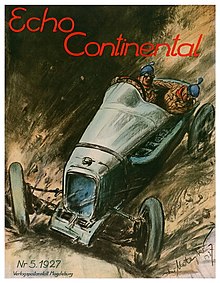
Cover by Theo Matejko for Echo Continental magazine

The first managing director of the Nürburgring was Alex Döhmer from Cologne from 1927 . The premiere was on Saturday, June 18, 1927 with the Eifel race for motorcycles over the overall 28 km course and one day later with an automobile race that Rudolf Caracciola won. He found the first mountain, race and test track with its many curves, slopes and jumping hills to be extremely difficult .
From the beginning, the route could also be used by anyone with a road vehicle for a fee in the evenings or on race-free weekends.
In the classic 22.8 km long Nordschleife variant, the circuit is still one of the most difficult Grand Prix circuits in the world. Jackie Stewart called the mountain-and-valley railway , which is surrounded by woods and hedges, a green hell . The difference in altitude between the sections of the route at Breidscheid on the one hand and the Hohe Acht or near Nürburg on the other hand is almost 300 meters.
There was also the lesser-known, 7.7-kilometer-long south loop that ran through the Müllenbach district . The possibility of combining the two to form a 28-kilometer course was rarely used from 1931 on, as was the case with the 84-hour Marathon de la Route in the 1960s. Sprint races were also held on the 2.2 km long course around the start and finish area (the start and finish loop or concrete loop), which was also used to warm up or start the stopwatch before a training lap served the full route.
A well-known driver, Čeněk Junek, had a fatal accident at the German Grand Prix in 1928 , and was followed by others in the 1930s. In 1954, the Argentine Onofre Marimón was the first Formula 1 driver to have a fatal accident at the Nürburgring. At the Grand Prix of Germany in 1958 , the Briton died Peter Collins . A few days after the 1966 Grand Prix , driver John Taylor died from burn injuries sustained in his accident. In 1969, Gerhard Mitter took part in Formula 1 training with a BMW Formula 2 and had a fatal accident at the Schwedenkreuz . The narrow stretch with hedges in many places directly on the edge of the road has been increasingly criticized since the late 1960s due to the ever faster vehicles.
In 1970 the Formula 1 drivers obtained a short-term boycott , whereupon the German Grand Prix was temporarily held at the Hockenheimring . This high-speed course was modified after Jim Clark's fatal accident in 1968, with the use of crash barriers that were missing on the three times as long Nürburgring.
1970 to 1983
After renovation work on the Nordschleife in 1970/71, Formula 1 returned to the Eifel for two three years, although further renovations were required each time. Due to the hillside location, however, none of the required wide run-out zones could be created in many places , as this would have required enormous earth movements. In addition, the ambulances always had to travel kilometers in the event of accidents. The shorter south loop was not rebuilt and from the mid-1970s it was no longer used for circuit races. There were several hill climbs starting in Müllenbach.
It was already clear beforehand that Formula 1 would have its last race at the Nürburgring on August 1, 1976 due to these safety deficiencies. This race was then overshadowed by Niki Lauda's serious fire accident , which, however, was not, as is still often rumored, the cause of the final relocation of the Formula 1 race to Hockenheim .
The motorcycle world championship last held a Grand Prix on the Nordschleife in 1980. Other racing series such as Formula 2 EM, German Racing Championship (DRM), ADAC 1000 km Nürburgring , Sports Car World Championship , etc. were able to hold their competitions - despite major concerns - until 1983, but on one during the ongoing renovation work Shortened course to 20.8 kilometers with a provisional pit system.
The new Grand Prix track
After Formula 1 only drove in Hockenheim from 1977 and other international series threatened to migrate, the possibilities of renewing the Nürburgring were discussed. In the end, the choice fell on a modern racetrack, only around 4.5 kilometers long, for reasons of cost, which only shared the start-and-finish straight with the old racetrack. The original Südschleife was abandoned and rededicated in the public transport area or used as access routes to parking lots. The shortened Nordschleife including the small pit system from 1983 still exists; it can be used largely independently of operations on the neighboring Grand Prix track, for example by the RCN and GLP .
In 1984 the Grand Prix track with its wide run-off areas was inaugurated with an event broadcast live on German television. The first race to be held on the new track was a show race with 20 identical Mercedes-Benz 190 E 2.3-16 touring cars in which many top-class racing drivers of the time competed, including nine former Formula 1 world champions: Jack Brabham (1959, 1960 , 1966), Phil Hill (1961), Denis Hulme (1967), James Hunt (1976), Alan Jones (1980), Niki Lauda (1975, 1977 - the title from 1984 was still in the future at this point), Keke Rosberg (1982), Jody Scheckter (1979) and John Surtees (1964). Other well-known names from Formula 1 were Elio de Angelis , Jacques Laffite , Stirling Moss , Alain Prost , Carlos Reutemann and John Watson . The winner, however, was the then little-known Brazilian Formula 1 newcomer Ayrton Senna , who had taken over the car originally intended for his compatriot Emerson Fittipaldi and who was the only one who managed not to overtake Niki Lauda, who started from the back row without training allow.
In the winter of 1994 and in May 1997 the Veedol chicane (later NGK chicane and now Veedol chicane again ) was rebuilt. This narrower route significantly reduces the speed of the vehicles. In addition, a separate route for motorcycle races was set up here.
In 2002 the route was extended to around 5.1 kilometers with the construction of the Mercedes Arena . In addition, the pit area was completely rebuilt in 2000, with a total of 33 garages that are so high that they are also suitable for trucks.
The Formula 1 World Championship held two races at the new Nürburgring in 1984 and 1985, but from 1986 the German Grand Prix was held again at the Hockenheimring. In return, the motorcycle world championship switched from Hockenheim to the Eifel for some races in the 1990s, but has been racing at the Sachsenring since 1998 .
From 1995 to 2006 a second Formula 1 race took place annually in Germany, which was called the Grand Prix of Europe (1997 and 1998 as the Grand Prix of Luxembourg , since the European Grand Prix 1997 as the season finale in Jerez [Spain] and 1998 did not take place at all). After the conversion in 2002, the distance was 60 laps or 308.863 kilometers.
In 2006 it became known that Formula 1 promoter Bernie Ecclestone, despite existing contracts with both racetracks, only wanted to allow one Grand Prix run per year in Germany from 2007, alternating annually at the Hockenheim and Nürburgring. The 2007 German Grand Prix was held at the Nürburgring as the European Grand Prix ; there was no German Grand Prix this year. Since the naming rights for it belong to the Automobile Club of Germany , this Grand Prix did not take place again until 2008 at the Hockenheimring.
In January 2007, the Rhineland-Palatinate Court of Audit accused the racetrack operators of mismanagement. The Formula 1 events in 2004 and 2005 each caused a loss of around nine million euros. Bernie Ecclestone-controlled Formula One Administration Ltd. (FOA) were paid about 16 million euros in attendance annually. The total costs per Grand Prix would increase by around ten percent annually.
On March 25, 2007, the Nürburgring-GmbH managing director Walter Kafitz announced that the "Shell" -S-curve between the Dunlop-Kehre and Kumho-curve (No. 11) should be renamed Michael-Schumacher -S . Schumacher personally came to the track for the christening of the curve on July 22, 2007 as part of the European Grand Prix.
In 2010 a biomass heating plant was put into operation. The company is run by RWE and the location is close to the leisure and business center.
But also various motorcycle, truck , oldtimer and DTM races as well as some one-make cups are at home on the GP circuit of the Nürburgring. Likewise, all single-seater series as well as GT racing cars and sports cars only run on this "safe" variant. Nevertheless, over the years some pilots suffered serious or even fatal injuries there too, but this was hardly to blame for the condition of the racetrack. Since the 2008 season , the German race for the Superbike World Championship has been held at the Nürburgring.
Routes
- Route 1927–1967
Start-and-finish loop / concrete loop in detail with start and finish straight
Nordschleife in detail with south bend
Südschleife in detail
- Route 1967–1983
Total route 1973–1982, 2nd wave of reconstruction, and a. Connection to the Südschleife
Nordschleife 1967–1982, with start-and-finish loop / concrete loop
- Routing since 1984
- Route variants of the current route
Other races
In conjunction with the 20.8-kilometer Nordschleife, up to 25.9-kilometer variants can be combined, on which touring cars hold VLN long-distance races lasting several hours and also the 24-hour race . Up to 190 cars of different degrees of modification, displacement and drive classes are in the running at the same time, with around 700 drivers (amateurs and professionals) taking turns at the steering wheels.
One of the most important events of the European classic car scene with up to 30,000 visitors takes place every year at the beginning of August, the AvD-Oldtimer-Grand-Prix. On the Grand Prix track, racing cars from different eras are driven to racing and regularity runs. At the same time, many classic car clubs meet in the parking lots around the Nürburgring.
In the evenings and on Sundays, anyone can drive their road vehicle on the Nordschleife for a fee. The entire route is also used for sports driver courses , where aspiring racing drivers and those interested in racing can learn the ideal line on the ring, for test drives in the automotive industry and the press, as well as for much-discussed record laps .
In the area of the Müllenbach loop in the southern part of the GP route there are not only the normal asphalt course but also additional gravel passages , which enabled the ADAC (Regional Club North Rhine) to organize rallycross races from 1991 to 1997 inclusive . The FIA International Cup races (a European rallycross cup for national teams) from 1992 and 1993 can be regarded as prestige international competitions in this discipline . In addition, the second Race of Champions in automotive history took place in this "Müllenbachschleife rallycross stadium" in 1989 . This mixed surface track was reactivated for August 2020 so that a run for the rallycross world championship can take place here in the future. However, it is now used in a counterclockwise direction instead of clockwise as in the 1990s and the gravel loop at the far end of the area is used for the so-called Joker Lap .
Every year, special stages of the Cologne-Ahrweiler rally lead over the remnants of the south loop and in the opposite direction over the north loop.
There were also hill climbs starting in Müllenbach , the lowest point on the Südschleife. Contrary to the usual direction, we drove up to the start and finish. Since the return then continued in a circle back to Müllenbach, uninterrupted operation was possible. Such mountain races could be carried out within one day with all training and valuation runs.
Up until 2002 there was a 1,300 meter long kart track next to the paddock . The Mercedes-Arena was built on this site and areas were paved for an extended paddock.
Other events
- Also known is the Rock am Ring music festival , which took place annually in the paddock area on the Nürburgring until 2014 and then moved to the nearby community of Mendig . It has taken place again at the Nürburgring since 2017. For this multi-day rock - event each year were around 80,000 visitors. In 2013 a new record was set at the sold-out festival with over 87,000 visitors.
- The Nordschleife has also been the venue for the Nürburgring race since 1978 , which now forms the Rad & Run am Ring event together with various cycling events (including a 24-hour cycle race) .
- The UCI Road World Championships have also taken place three times at the Nürburgring , in 1927, 1966 (World Champion Rudi Altig ) and 1978.
- The Rad am Ring cycling event has been taking place on the Nordschleife and in the area between the start and finish area and the Nürburg since 2003 . In 2012, over 5,000 cyclists took part in racing bike and mountain bike races. You start as a single driver, in teams of 2, 4 and 8 in a 24-hour or everyone-race, or in touring.
- The Fisherman's Friend StrongmanRun has been taking place around the Nürburgring since 2011 . Around 13,000 runners take part each year in the obstacle course, which is similar to the English Tough Guy Race . In 2014 the route comprised 2 laps of 12 km each with 17 obstacles per lap.
Nürburgring 2009
Under the project name Nürburgring 2009 , the Erlebniswelt building and the adjoining car park were demolished from November 22, 2007, and the surroundings of the Nürburgring were converted and expanded. Instead of the blown T3 main grandstand opposite the boxes, a new main grandstand was created with space for 5,000 people. A VIP lounge for 600 people was set up in the upper part of the grandstand. A substantial part of this grandstand building was used for offices for the administration of the Nürburgring. They are shielded from the racetrack by complex soundproof glazing. Until then, the administration was housed in houses A and B on Bundesstraße 258 , which were built in the early days of the racetrack .
By summer 2009, an adventure mile, the so-called ring ° boulevard , was built between the main road and the start-finish straight . Shops for leading automobile manufacturers and suppliers have been established there. Furthermore, the boulevard was supplemented with a 4,000 m² hall with 4,500 seats, in addition to the existing Dorint hotel, a new 4-star hotel ( Lindner Hotels AG , at grandstand T4) and an indoor theme park. On the other side of the main road, the Eifel village was a collection of restaurants and discos. In Meuspath a motorsport holiday village was furnished, the additional accommodation facilities in around 100 holiday homes.

The official opening of the “new Nürburgring” took place on July 10th, 2009, but most of the new attractions were not yet in operation at that time. The biggest attraction was to be the so-called ring ° racer - a roller coaster whose special feature is the enormous acceleration at the start. This launch coaster was accelerated with air pressure. It was symbolically opened with celebrities at the Grand Prix . After two explosions with injuries occurred during the test drives in summer 2009, the ride was not put into operation. Full operation only started on October 31, 2013. However, on November 3, 2013, driving was completely stopped again.
The Nürburgring 2009 project , into which around 350 million euros flowed from taxpayers' money, led to the resignation of the Rhineland-Palatinate Finance Minister and Chairman of the Supervisory Board of Nürburgring GmbH, Ingolf Deubel , in the summer of 2009 . From October 2012, a lawsuit against him before the district court in Koblenz was accused of infidelity in connection with the failed private financing of the amusement park. In April 2014, he was sentenced to three years and six months in prison for infidelity and unofficial false testimony in the investigative committee of the Rhineland-Palatinate state parliament . The former managing director of Nürburgring GmbH, Walter Kafitz, who was also accused, was sentenced to a suspended sentence of one year and seven months for breach of trust in seven cases. The court imposed a suspended sentence of eight months on the former controller of Nürburgring GmbH, Michael Nuss, for four cases of infidelity. During the trial there were differences between Deubel and Nuss after the latter testified that Deubel had been the driving force behind numerous fateful decisions. Deubel had, although he was only a member of the supervisory board of Nürburgring GmbH, repeatedly issued orders and in fact often ran the business. The judgment is not final. The defense lawyers of Deubel and Nuss appealed and the Attorney General spoke out in favor of carrying out some of the proceedings before the Koblenz Regional Court again.
On September 16, 2009, an elaborate committee of inquiry started in the state parliament , which was supposed to disclose the responsibilities of the failed private financing. A future project presented on December 2, 2009 by the state government of Rhineland-Palatinate provided for the division into an operating and an operating company, the managing director of Nürburgring GmbH, Walter Kafitz , was dismissed. The division into operating and operating company took place on May 2, 2010, both the two race tracks (Grand Prix track and Nordschleife) and the newly created adventure world including the two new hotels and the new holiday park in Drees have since been managed by the newly founded Nürburgring Automotive GmbH operated. This is owned 50 percent each by Lindner Hotels AG and the real estate developer Mediinvest . Nürburgring GmbH has existed since then as a pure holding company, 90 percent of which is owned by the state of Rhineland-Palatinate. Since then, this company has owned and managed all properties in the leisure and business center.
with Lindner-Hotel, ring ° racer, Warsteiner Event-Center, ring ° arena, ring ° boulevard and ring ° werk (from left to right)
criticism
The then Prime Minister of Rhineland-Palatinate, Kurt Beck , had emphasized that the project would not cost taxpayers a euro. The makers of the failed Space Park Bremen were hired as consultants . In the search for investors, dubious financial intermediaries were commissioned and, among other things, a sum of 95 million euros was transferred to Liechtenstein to prove the liquidity of the federal state of Rhineland-Palatinate . After no investor was found, the entire investment was financed, at least for the time being, from taxpayers' money and construction began. State Finance Minister Ingolf Deubel came under fire because the financing of the expansion was to take place via highly speculative funds, Liechtenstein accounts and unknown business partners in Dubai . On July 7th, 2009 Deubel resigned due to criticism of the business conduct of a Swiss broker in the private financing of the planned leisure center. In addition, the critically reporting journalist Wilhelm Hahne had been searched.
The project was rejected in circles of the private sector gastronomy of the surrounding area, because from their point of view instead of the promised structural improvement a competition subsidized with tax money arose. The state's expected return on investments - Kurt Beck spoke in 2007 of an amortization after just three years - were "completely out of thin air and unrealistic, since the necessary framework conditions and figures at the Nürburgring cannot be achieved".
In December 2012, the weekly newspaper Die Zeit uncovered that the Koblenz public prosecutor and the Rhineland-Palatinate State Criminal Police Office had already scrutinized the Swiss businessman Urs Barandun in March 2009 after an informant had reported to the LKA that it had already happened in the past had come to abnormalities in business in Barandun. After a discussion between the two authorities, however, the matter was not further investigated.
Bankruptcy and Sale
On February 7, 2012, the state government of Rhineland-Palatinate decided to terminate the lease agreement with Nürburgring Automotive GmbH, as lease payments to Nürburgring GmbH had not been made. Unprofitable parts of the amusement park were to be closed, and 92 jobs were planned to be cut.
Since the aid of 13 million euros applied for by the state of Rhineland-Palatinate in July 2012 was not approved in time by the EU Commission , Nürburgring GmbH initiated a procedure for impending insolvency. On July 18, 2012, the employees were informed about insolvency, and from July 23, 2012, the insolvency administrator took over the management of Nürburgring GmbH.
The budget and finance committee of the state parliament activated reserves of 254 million euros on August 1, 2012 in order to service a guarantee for a loan granted to the insolvent operating company. Prime Minister Beck apologized to the state parliament.
The bankruptcy proceedings were officially opened on November 2, 2012. The aim of the insolvency under self-administration was to re-market the racetrack. Sales of the racetrack should begin in April 2013. A law or a dedication should ensure that private individuals can continue to use the racetrack in the future. A buyer should be found by the end of 2013.
In mid-May 2013, the race track, amusement park and hotel were offered for sale. The tender ran until June 12, 2013. According to the insolvency administrator, the total package was valued at around 120 million euros. The total loss for the taxpayer was around 330 million euros.
On March 11, 2014, the creditors announced that the Nürburgring would be sold to the automotive supplier Capricorn for 77 million euros . Capricorn announced that it will invest a further 25 million euros in the Nürburgring and that it intends to close the “Green Hell” adventure village and the roller coaster immediately when the takeover takes effect on January 1, 2015. The Russian billionaire Viktor Charitonin has held two thirds of the shares in the Nürburgring through NR Holding since the end of October 2014 . He has thus taken over the Capricorn shares. Another third still belongs to Getspeed.
The European Union is checking whether the aid amounting to 480 million euros has been lawfully paid. Already at the beginning of the sales process it became known that potential investors would not accept any aid repayment claims. Capricorn has also agreed a right of withdrawal in the sales contract in the event that aid is reclaimed. On October 1, 2014, it became known that the EU Commission considers aid amounting to 456 million euros to be incompatible with EU state aid rules.
statistics
Route data
- Route length: 5.148 kilometers
- Lap distance: 60 laps (308.863 kilometers)
- Length of the pit lane: 381.4 meters
Course records F1
22.8 km route (1951–1976)
- Qualification: 6: 58.6 min (Niki Lauda, Ferrari, 1975)
- Race: 7: 06.4 min (Clay Regazzoni, Ferrari, 1975)
4.5 km route (1984-2001)
- Qualification: 1: 14.960 min (Michael Schumacher, Ferrari, 2001)
- Race: 1: 18.354 min (Juan Pablo Montoya, Williams, 2001)
5.1 km route (since 2002)
- Qualification: 1: 28.351 min (Michael Schumacher, Ferrari, 2004)
- Race: 1: 29.468 min (Michael Schumacher, Ferrari, 2004)
All winners of Formula 1 races on the Nürburgring
Nordschleife (1951–1976)
| No. | year | driver | constructor | engine | tires | time | Route length | Round | Ø pace | date | GP of |
|---|---|---|---|---|---|---|---|---|---|---|---|
| 1 | 1951 |
|
Ferrari | Ferrari | P | 3: 23: 03,300 h | 22.810 km | 20th | 134.801 km / h | 29th of July |
|
| 2 | 1952 |
|
Ferrari | Ferrari | E. | 3:06: 13,300 h | 22.810 km | 18th | 132.288 km / h | 3 Aug | |
| 3 | 1953 |
|
Ferrari | Ferrari | P | 3:02: 25,000 h | 22.810 km | 18th | 135.047 km / h | 2nd Aug | |
| 4th | 1954 |
|
Mercedes | Mercedes | C. | 3: 45: 45.800 h | 22.810 km | 22nd | 133.366 km / h | 1 Aug |
|
| 5 | 1956 |
|
Ferrari | Ferrari | E. | 3: 38: 43.700 h | 22.810 km | 22nd | 137.656 km / h | 5th Aug |
|
| 6th | 1957 |
|
Maserati | Maserati | P | 3:30: 38,300 h | 22.810 km | 22nd | 142.943 km / h | 4th Aug | |
| 7th | 1958 |
|
Vanwall | Vanwall | D. | 2: 21: 15,000 h | 22.810 km | 15th | 145.338 km / h | 3 Aug | |
| 8th | 1961 |
|
lotus | Climax | D. | 2: 18: 12,400 h | 22.810 km | 15th | 148.538 km / h | 6 Aug |
|
| 9 | 1962 |
|
BRM | BRM | D. | 2: 38: 45,300 h | 22.810 km | 15th | 129.312 km / h | 5th Aug |
|
| 10 | 1963 |
|
Ferrari | Ferrari | D. | 2: 13: 06,800 h | 22.810 km | 15th | 154.222 km / h | 4th Aug | |
| 11 | 1964 |
|
Ferrari | Ferrari | D. | 2: 12: 04,800 h | 22.810 km | 15th | 155.429 km / h | 2nd Aug | |
| 12 | 1965 |
|
lotus | Climax | D. | 2: 07: 52.400 h | 22.810 km | 15th | 160.542 km / h | 1 Aug | |
| 13 | 1966 |
|
Brabham | Repco | G | 2: 27: 03,000 h | 22.810 km | 15th | 139.606 km / h | 7 Aug | |
| 14th | 1967 |
|
Brabham | Repco | G | 2:05: 55,700 h | 22.835 km | 15th | 163.200 km / h | 6 Aug | |
| 15th | 1968 |
|
Matra | ford | D. | 2: 19: 03,200 h | 22.835 km | 14th | 137.943 km / h | 4th Aug |
|
| 16 | 1969 |
|
Brabham | ford | G | 1: 49: 55.400 h | 22.835 km | 14th | 174.498 km / h | 3 Aug |
|
| 17th | 1971 |
|
Tyrrell | ford | G | 1: 29: 15.700 h | 22.835 km | 12 | 184.191 km / h | 1 Aug | |
| 18th | 1972 |
|
Ferrari | Ferrari | F. | 1: 42: 12,300 h | 22.835 km | 14th | 187.676 km / h | 30th July | |
| 19th | 1973 |
|
Tyrrell | ford | G | 1: 42: 03,000 h | 22.835 km | 14th | 187.961 km / h | 5th Aug | |
| 20th | 1974 |
|
Ferrari | Ferrari | G | 1: 41: 35,000 h | 22.835 km | 14th | 188.824 km / h | 4th Aug |
|
| 21st | 1975 |
|
Brabham | ford | G | 1: 41: 14.100 h | 22.835 km | 14th | 189.474 km / h | 3 Aug |
|
| 22nd | 1976 |
|
McLaren | ford | G | 1: 41: 42.700 h | 22.835 km | 14th | 188.586 km / h | 1 Aug | |
Record winner
Driver: Juan Manuel Fangio / Jackie Stewart (3 each) • Driver nations: Great Britain (10) • Constructors: Ferrari (8) • Engine manufacturer: Ferrari (8) • Tire manufacturer: Goodyear (8)
Grand Prix course (1984-2020)
| No. | year | driver | constructor | engine | tires | time | Route length | Round | Ø pace | date | GP of |
|---|---|---|---|---|---|---|---|---|---|---|---|
| 1 | 1984 |
|
McLaren | Porsche ( TAG ) | M. | 1: 35: 13.284 h | 4.542 km | 67 | 191.751 km / h | Oct 7 |
|
| 2 | 1985 |
|
Ferrari | Ferrari | G | 1: 35: 31.337 h | 4.542 km | 67 | 191.147 km / h | 4th Aug |
|
| 3 | 1995 |
|
Benetton | Renault | G | 1: 39: 59.044 h | 4.556 km | 67 | 183.180 km / h | Oct. 1 |
|
| 4th | 1996 |
|
Williams | Renault | G | 1: 33: 26.473 h | 4.556 km | 67 | 196.007 km / h | Apr 28 | |
| 5 | 1997 |
|
Williams | Renault | G | 1: 31: 27.843 h | 4.556 km | 67 | 200.244 km / h | 28 Sep |
|
| 6th | 1998 |
|
McLaren | Mercedes | B. | 1: 32: 14.789 h | 4.556 km | 67 | 198.545 km / h | 27 Sep | |
| 7th | 1999 |
|
Stewart | ford | B. | 1: 41: 54.314 h | 4.556 km | 66 | 177.034 km / h | 26 Sep |
|
| 8th | 2000 |
|
Ferrari | Ferrari | B. | 1: 42: 00.307 h | 4.556 km | 67 | 179.541 km / h | May 21 | |
| 9 | 2001 |
|
Ferrari | Ferrari | B. | 1: 29: 42.724 h | 4.556 km | 67 | 204.143 km / h | June 24th | |
| 10 | 2002 |
|
Ferrari | Ferrari | B. | 1: 35: 07.426 h | 5.146 km | 60 | 194.742 km / h | 23rd June | |
| 11 | 2003 |
|
Williams | BMW | M. | 1: 34: 43.622 h | 5.148 km | 60 | 195.633 km / h | June 29th | |
| 12 | 2004 |
|
Ferrari | Ferrari | B. | 1: 32: 35.101 h | 5.148 km | 60 | 200.160 km / h | 30th May | |
| 13 | 2005 |
|
Renault | Renault | M. | 1: 31: 46.648 h | 5.148 km | 59 | 198.555 km / h | May 29th | |
| 14th | 2006 |
|
Ferrari | Ferrari | B. | 1: 35: 58.765 h | 5.148 km | 60 | 193.081 km / h | May 7th | |
| 15th | 2007 |
|
McLaren | Mercedes | B. | 2: 06: 26.358 h | 5.148 km | 60 | 146.567 km / h | 22nd of July | |
| 16 | 2009 |
|
Red Bull | Renault | B. | 1: 36: 43.310 h | 5.148 km | 60 | 191.599 km / h | July 12 |
|
| 17th | 2011 |
|
McLaren | Mercedes | P | 1: 37: 30.224 h | 5.148 km | 60 | 190.059 km / h | 24th July | |
| 18th | 2013 |
|
Red Bull | Renault | P | 1: 41: 14.711 h | 5.148 km | 60 | 182.896 km / h | 7th of July | |
Record winner
Driver: Michael Schumacher (5) • Driver nations: Germany (7) • Constructors: Ferrari (6) • Engine manufacturer: Ferrari / Renault (6 each) • Tire manufacturer: Bridgestone (7)
Event radio
The Nürburgring has a VHF transmitter for an event radio that works on the frequency 87.7 MHz with 50 W ERP. The antenna is located at a height of 44 meters on a spun concrete mast at 50 ° 20'22.59 "N 6 ° 56'51.02" E. When there is no event, the transmitter is used to broadcast the RPR1 program. SWR3 is broadcast on “Rock am Ring”.
literature
- L. Jonasz: The Nürburg-Ring . In: Journal of the Association of German Engineers . 71st year, no. 32 , August 6, 1927, p. 1129-1132 .
- Jörg-Thomas Födisch: Nürburgring - The chronicle of the legendary race track . Verlagsunion Erich Pabel - Arthur Moewig KG, Rastatt 1991, ISBN 3-8118-3065-1 .
- Jörg-Thomas Födisch, Robert Ostrovsky: Green Hell Nürburgring: an image and text documentation . Brühl, Giessen 1995, ISBN 3-922300-53-7 .
- Jörg-Thomas Födisch, Robert Ostrovsky : Around the "Ring": an image documentation of places in the vicinity of the most famous race track in the world, the Nürburgring, before it was built and by himself . Geiger, Horb am Neckar 1996, ISBN 3-89570-248-X .
- Jörg-Thomas Födisch, Ostrovsky, Robert: The Nürburgring: the legendary race track from 1927 until today . Heel, Königswinter 2000, ISBN 3-89365-841-6 .
- Michael Behrndt, Jörg-Thomas Födisch: 75 years of the Nürburgring. A racetrack in the rearview mirror . Heel Verlag, Königswinter 2002, ISBN 3-89880-083-0 .
- Klaus Ridder : Heroes of the Nürburgring . Sutton Verlag, Erfurt 2006, ISBN 3-86680-073-8 .
- Wolfgang Förster: Fascination Nürburgring - yesterday & today . Heel Verlag, Königswinter 2011, ISBN 978-3-86852-496-3 .
- Wilhelm Hahne (author), Peter Doeppes (illustrator): "Nürburgring 2009". Scandal? Affair? Südwest- und Eifelzeitung Verlags- und Vertriebs-GmbH, Daun 2010, ISBN 978-3-9810588-2-6 .
- Ferdi Kräling, Gregor Messer: Green Hell Nürburgring - Fascination Nordschleife . 1st edition. Delius Klasing, Bielefeld 2011, ISBN 978-3-7688-3274-8 .
Web links
- Nürburgring GmbH website
- New information portal about the events at the Nürburgring
- Onboard video of a lap GP course (MP4; 14.9 MB)
- Pictures from the 1950s
- Sale to Capricorn
Individual evidence
- ^ Renovated Hell , Spiegel article 19/1984, accessed on September 22, 2010.
- ↑ a b Automotive supplier buys insolvent Nürburgring. Die Welt, March 11, 2014, accessed March 11, 2014 .
- ↑ Official press release on the takeover of the Nürburgring by the Capricorn Group. (pdf) (No longer available online.) Capricorn Group, March 11, 2014, archived from the original on March 12, 2014 ; accessed on March 11, 2014 .
- ↑ a b A surprise winner and many losers WirtschaftsWoche, March 12, 2014, accessed on March 12, 2014
- ↑ "Insolvent racetrack: Russian oligarch joins the Nürburgring". In: spiegel.de. October 30, 2014, accessed October 30, 2014 .
- ^ Jörg-Thomas Födisch: Nürburgring ; page 4
- ↑ a b Jörg-Thomas Födisch: Nürburgring ; page 5
- ↑ a b Jörg-Thomas Födisch: Nürburgring ; page 6
- ^ From the emergency measure to the gold mine ( Memento of November 8, 2007 in the Internet Archive ), Landessportbund Rheinland-Pfalz
- ^ Jörg-Thomas Födisch: Nürburgring; page 8
- ↑ List of results from the show race on May 12, 1984 at the Nürburgring. In: PistonHeads.com. Retrieved December 2, 2011 .
- ↑ Back to tradition: Nürburgring again with Veedol chicane. In: Nuerburgring.de. Retrieved September 4, 2015 .
- ^ "Nürburgring: Green Hell", WirtschaftsWoche March 18, 2007 ( page no longer available , search in web archives )
- ↑ “S like Schumacher”, Formel1.de March 25, 2007 ( Memento from September 28, 2007 in the Internet Archive ), www.motorsport-total.com - Nürburgring names curve after Schumacher
- ↑ AvD-Oldtimer-Grand-Prix-Homepage (found on March 24, 2009)
- ↑ SPIEGEL Online: "Rock am Ring" is returning to the Nürburgring. http://www.spiegel.de/kultur/musik/rock-am-ring-kehrt-zurueck-an-den-nuerburgring-mendig-nicht-mehr-haltbar-a-1124475.html
- ↑ Picture from the groundbreaking Nürburgring 2009. On 20832.com, accessed on January 9, 2019.
- ↑ Kai Ebel: That's how it was with Schumi and Lilly in the roller coaster. July 14, 2009. From Bild.de, accessed January 9, 2019.
- ↑ Ringracer roller coaster does not start until 2011. Article in Volksfreund from October 15, 2010, accessed on October 15, 2010.
- ↑ Official start ring racer at the Nürburgring. (No longer available online.) In: wochenspiegellive.de. October 31, 2013, archived from the original on November 3, 2013 ; Retrieved December 6, 2013 .
- ↑ Recourse claims against ex-Ring boss Kafitz. Retrieved from Trierischer Volksfreund on March 26, 2010.
- ↑ Ex-Finance Minister Deubel sentenced to imprisonment. From Sueddeutsche.de, accessed on April 16, 2014.
- ↑ Kurt Beck's ex-finance minister has to be imprisoned for 3.5 years. Die Welt, accessed April 16, 2014.
- ↑ Nürburgring trial Ingolf Deubel was imprisoned for three and a half years. SWR Landesschau aktuell Rhineland-Palatinate , April 16, 2014, accessed on October 22, 2015 .
- ↑ Marcus Rohwetter and Dagmar Rosenfeld: Nürburgring: One of the lies in the Eifel thriller. Die Zeit, March 14, 2013, accessed on October 22, 2015 .
- ↑ Ursula Samary: Ring: Do all convicts see each other again in court? Rhein-Zeitung, April 27, 2015, accessed on October 22, 2015 .
- ↑ Handover completed at the Nürburgring. May 6, 2010. From Motorsport-Total.com, accessed January 8, 2019.
- ↑ New structures at the Nürburgring: Land becomes the owner of all buildings. Retrieved from Trierischer Volksfreund on March 26, 2010.
- ↑ a b Heike Anger: Of bankruptcies, bad luck and breakdowns . In: Handelsblatt . No. 148, August 2, 2012, ISSN 0017-7296 , p. 13.
- ^ NDR: Schikane - raid on a critical journalist ( memento of August 30, 2010 in the Internet Archive ), July 1, 2009 (article in the Internet Archive ).
- ↑ Minutes of the meeting of the Nürburgring interest group to reactivate the Nürburg citizens' initiative. V. In: rettet-den-ring.de. March 11, 2007, accessed November 16, 2011 .
- ↑ Marcus Rohwetter, Dagmar Rosenfeld: In case of doubt against the prosecutor. DIE ZEIT No. 51, December 23, 2012, accessed on December 24, 2012 .
- ↑ Termination: Red-Green parted ways with private operators at the Nürburgring. Allgemeine Zeitung Rhein-Main-Presse, February 7, 2012, accessed on February 21, 2012 .
- ↑ Slowed down: Nürburgring goes into bankruptcy. (No longer available online.) In: heute.de. ZDF, July 18, 2012, formerly in the original ; Retrieved July 18, 2012 . ( Page no longer available , search in web archives )
- ↑ Ludger Fittkau : Insolvency administrator takes over the Nürburgring - the red-green state government blames Brussels. Deutschlandradio, July 18, 2012, accessed on July 18, 2012 .
- ↑ Nürburgring: Insolvency proceedings opened , Trierische Volksfreund dated November 2, 2012, accessed on November 3, 2012.
- ↑ Nürburgring remains a race track . In: Handelsblatt . No. 50 , March 22, 2013, ISSN 0017-7296 , p. 22 .
- ↑ a b M. Buchenau: Nürburgring with amusement park is for sale . In: Handelsblatt . May 15, 2013, ISSN 0017-7296 , p. 17 .
- ↑ H. Anger, D. Delhaes, FM Drost, D. Fockenbrock, F. Gartmann, M. Murphy: Loss of control of the controllers . In: Handelsblatt . No. 5 , January 8, 2013, ISSN 0017-7296 , p. 1, 4 .
- ↑ Insolvent race track: Russian oligarch enters the Nürburgring. In: spiegel.de. October 30, 2014, accessed October 30, 2014 .
- ↑ Aid for the Nürburgring was not permitted. In: faz.net. October 1, 2014, accessed October 1, 2014 .
- ↑ "Facts and Figures" ( Memento from February 13, 2006 in the Internet Archive ) (Official website Nürburgring GmbH)
- ↑ FMSCAN . Retrieved July 15, 2018.
